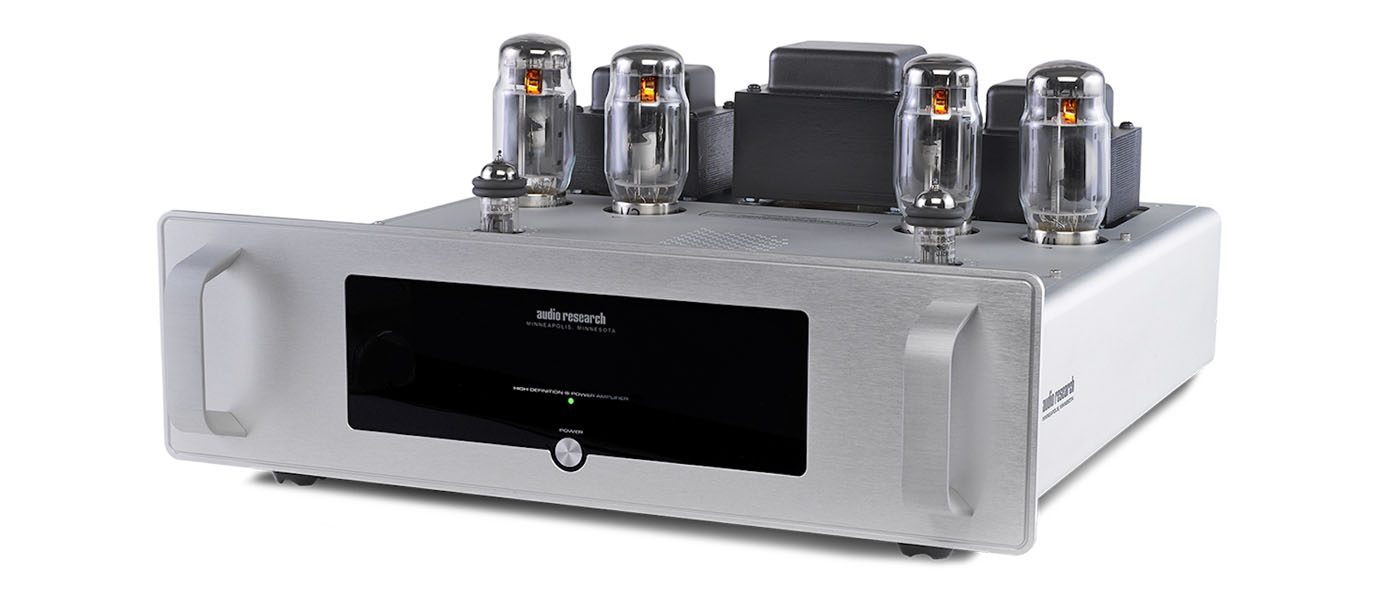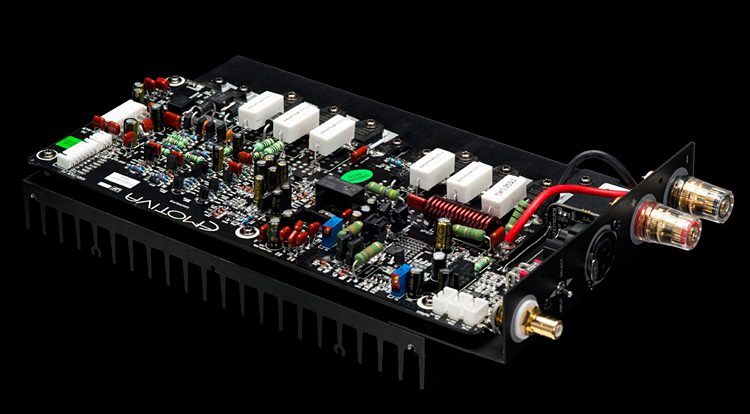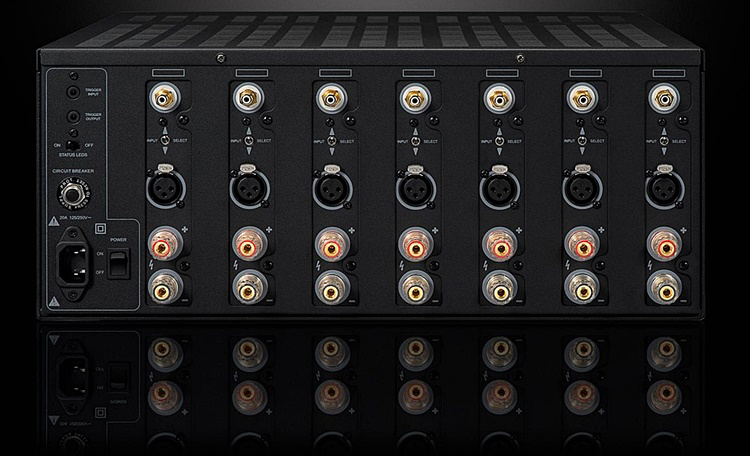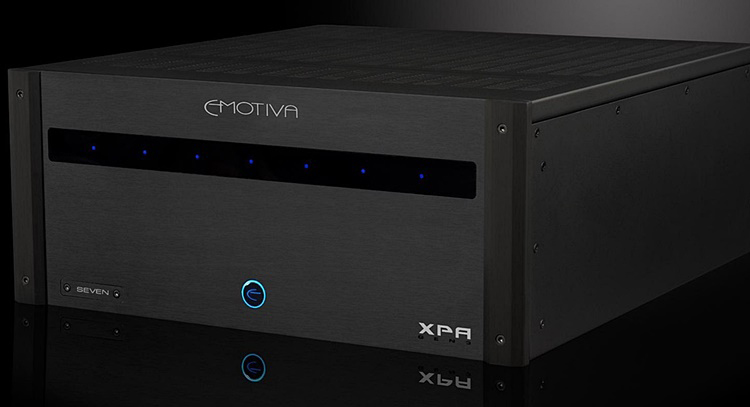Their latest release is the XPA Gen3 series amplifiers. This is the next incarnation of their venerable XPA amplification line. All Gen3 amps share the same chassis and high-current switch mode power supply module with multiple power rails for Class H operation. They can then be configured for anywhere between two to seven channels through an individual modular Class A/B power amplifier “blades”. The amplifier modules are rated at up to 300 watts per channel (8 ohms) for the two channel configuration down to 200 w.p.c. on the seven channel set up. And power rating is with all channels driven. Each power amplifier module has its own Class H control circuitry and high current FET rail switches for improved efficiency.
This amp delivered the goods power-wise but also impressed with a balanced, detailed sound.
Emotiva XPA Gen3 Power Amplifier
- Modular design – two to seven channels
- High power output (200 – 300 wpc, depending on configuration)
- Modern Class H topology
- Proven and reliable Class AB output stages
- High current switch mode power supply
- Lighter weight than the competition
- Excellent audio quality
I first saw these amps at the 2015 Winter CES Show. Emotiva was in the Venetian with a great many new products to show. Though they had the XPA Gen3 amps there, they were non-working prototypes. But the design really piqued my interest nontheless. A modular case with up to seven channels and power to spare (up to 300 watts per channel).
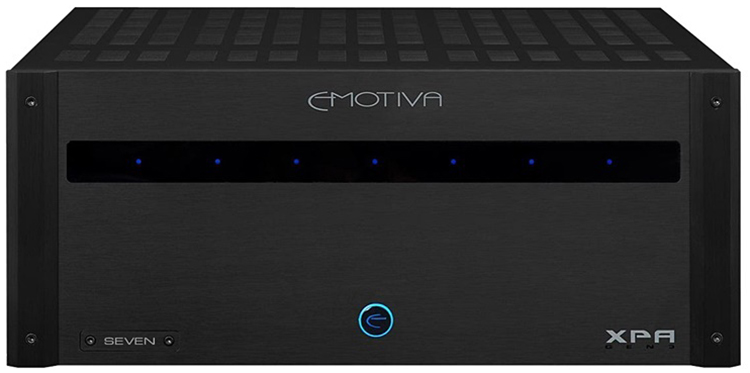
FTC Rated Power (2 channels driven): 20Hz – 20kHz, <0.1% THD:
300 watts RMS per channel; THD < 0.1%; into 8 Ω
490 watts RMS per channel; THD < 0.1%; into 4 Ω
Power Out Per Channel (All Channels Driven): THD <0.1%, into 8 Ω:
Two Channels: 300 watts RMS per channel
Three Channels: 275 watts RMS per channel
Four Channels: 260 watts RMS per channel
Five Channels: 250 watts RMS per channel
Six Channels: 225 watts RMS per channel
Seven Channels: 200 watts RMS per channel
Power Bandwidth (Rated Power, 8 Ω load):
20 Hz to 20 kHz (+/- 0.1 dB)
Broad Band Frequency Response:
5 Hz to 80 kHz (+ 0/- 0.15 dB)
Signal to Noise Ratio (8 Ω load):
> 117 dB; ref FTC rated power; unbalanced input (A-weighted)
> 91 dB; ref 1 watt; unbalanced input (A-weighted)
Minimum Recommended Speaker Impedance:
4 Ω
Damping Factor (8 Ω load):
> 500
Input Sensitivity for rated power, 8 Ohm load:
1.5 V
Gain:
29 dB
Input Impedance:
33 kΩ (balanced)
23.5 kΩ (unbalanced)
Dimensions (unboxed):
17” (w) x 8” (h) x 19” (d) (with feet)
17” (w) x 7” (h) x 19” (d) (without feet)
Weight (unboxed):
XPA two Gen3: 35.5 lbs
XPA three Gen3: 39 lbs
XPA four Gen3: 42.5 lbs
XPA five Gen3: 46 lbs
XPA six Gen3: 49.5 lbs
XPA seven Gen3: 53 lbs
MSRP:
$ 899 – 1,899 (USD, 2 – 7 channels)
Company:
SECRETS Tags:
Emotiva, Emotiva XPA, Emotiva Gen3, Power Amplifier, Power Amplifier Reviews 2016
That wasn’t all; the amps were based on a new Class H amplifier design and a switch mode power supply. With my growing concerns about the environment, I am always seeking components that use modern technology to reduce waste and power consumption. But I haven’t always liked the sound of Class D amps so I thought a Class H design might very well offer a good compromise between energy efficiency and audio quality.
Secrets Sponsor
So you can see that I was very interested to review one of these and I was fortunate to receive one of the first production units for this review. I was able to see first- hand if this product could live up to the hype.
This amplifier embodies more than a few interesting advancements and features that are borne of several design advancements by Emotiva. I consider its modular architecture to be the most important of these features but this modular design is only made possible because of the amp’s high tech power supply. In a nutshell, the Emotiva XPA Gen3 amplifier can be configured for two to seven channels depending on the number of amplifier modules installed in its modular case. The high current switch mode power supply is on a separate card and it is shared among all the installed amplifier modules.
This explains the interesting power ratings in the Specifications sidebar. Each output module is designed to be capable of up to 300 watt RMS output into 8 ohms. But the power supply, though quite robust, is nevertheless limited in its capacity. So the power ratings range from a high of 300 wpc for a two channel configuration down to 200 wpc when set up for 7 channels. Bear in mind, these ratings are FTC ratings with all channels driven (RMS, continuous power output).
I see this sharing of a single power supply as something of a hallmark for Emotiva’s multi- channel amps from the very beginning. It makes a lot of sense to me. Look at it this way, the 7-channel Emotiva XPA Gen3 amp I have in front of me produces 7 x 200 watts, which means it is essentially a 1,400 watt amp. Let’s say you really crank it up and the front three channels are popping 250 watts each (this would be extremely loud with anything but the most inefficient speakers). Then you would have 650 watts hanging (1,400 – 3 x 250 = 650). That leaves 650 / 4 = 162.5 watts available for each of the other four channels. On most soundtracks, it is unusual for the rear, back or height speakers to play anywhere near this level when the fronts are raging as in this example. Then when you turn around and listen to two-channel sources in a stereo configuration you all of a sudden have 300 wpc on tap. It is in many respects the best of both worlds.
Secrets Sponsor
The modular design of the XPA Gen3 amplifier is marketed to consumers who may want to start out with a few channels and then upgrade when they expand their system. This was true for me. My initial surround system was a 5.1 system but I needed to move up to a 7-channel amp when I installed height speakers for a 5.1.2 Dolby Atmos set up. But I think relatively few people would go this route (adding channels). I think a more likely scenario would be to buy two or more XPA Gen3’s, thereby getting even more power. For example, consider a 3-channel unit for the fronts and a 4 or 6-channel unit for the surrounds. This would yield more power. And the value price of these amps makes this a very appealing concept.
Let’s take a minute to talk about the circuit topology. The circuitry in each output module is based on Emotiva’s exceptional-sounding short signal path Class A/B output circuits that were designed for their XPA Gen1 and Gen2 amplifiers. I have used an Emotiva XPA 5-channel amplifier for years and can attest the sound is strong, rich, clean and dynamic. I can fully understand why Emotiva wouldn’t fiddle with such a successful design.
But the real story here is the XPA Gen3 power supply. The Switch Mode Power Supply (SMPS) Emotiva designed combines high efficiency, substantial long term power capacity and significant short term dynamic power reserves. The controller chip and basic circuit design used in Emotiva’s new SMPS have a long track record of reliably powering commercial and automotive devices.
Emotiva’s Soft-Switch™ Class H power supply topology increases the efficiency of the new XPA amplifiers. At lower power levels, the amplifiers operate on a lower supply voltage to minimize quiescent power consumption and standby power losses. When the amplifier control circuitry detects a fast rising input signal that will exceed the lower power voltage, it instantly switches to a higher voltage rail to ensure that the signal can pass cleanly without clipping. This process happens on a continuous basis, in real time and it allows greater efficiency than previous designs.
I recently reviewed the Arcam AVR850 receiver which uses Class G amplification. Emotiva’s Class H design bears many similarities to a Class G amp with the biggest difference being that Class G amps have discrete voltage rails where a Class H amp operates with “infinitely” variable supply rails. The most critical part in either design is the frequency of the switching devices which, despite great advances in recent years, are still plagued somewhat by lower signal to noise ratios than you would see with a linear power supply.
The Emotiva XPA Gen3 amplifier is housed in a heavy steel 4RU chassis with a milled aluminum faceplate. This is a solid and good-looking case. Emotiva maintained much of the family appearance, albeit in an all-black front panel – the soft touch power toggle with the blue Emotiva logo and the status LED’s that glow blue or red depending on each channel’s condition.
Around back, there are both balanced an unbalanced inputs, Gold plated five-way speaker binding posts with clear shields, a DC trigger input and output and a main power toggle. The status LED’s can be toggled on or off via a rear panel switch. Finally, the unit automatically senses and operates on any line voltage between 100 VAC and 250 VAC 50/60Hz and is protected from faults by a rugged resettable circuit breaker.
Setting up and installing this amplifier was very straightforward. Emotiva doesn’t sell the output modules directly to consumers. You either get your amp configured at the factory or by your authorized dealer. Adding modules would be the most complex part of the set up so thankfully you don’t need to mess around with that.
What this means is that I had a 7-channel power amp that despite its high tech design was essentially as easy to install as any other balanced multi-channel power amp. It was in some ways easier to install because the advanced circuitry leads to a lower unit weight which is a much welcomed “feature” when moving it around and getting it into the rack.
I used the balanced XLR inputs for this review. I connected them and verified that the input toggles were all set to the balanced input setting. The Emotiva’s XLR inputs are of the locking variety which is a nice touch. (The unbalanced RCA’s are the heavy duty machined type that are mounted to the back panel – not to a circuit board; also a nice, high-end touch.)
I then connected the speakers using banana plugs. I use banana plugs because I’m a reviewer and this streamlines switching out components. If I were not a reviewer, then I would use bare wire or spades which give a better electrical connection particularly with Emotiva’s high quality gold-plated binding posts.
I then connected the trigger cable from my pre pro, plugged the unit into the wall and turned on the main power toggle. In this set up, the unit remains in standby until it senses a turn on voltage from the trigger at which point the amp automatically switches into active operation mode. When you turn off your pre pro, then the toggle switches off the amp. I used the amp in this configuration throughout the review.
Once I had the amplifier all set up and ready to roll, I was actually very much excited to give it a listen. Like I mentioned earlier, I was just coming off my review of the Arcam AVR 850 receiver. The Arcam has Class G amplification which is a close cousin to the Class H design of the Emotiva XPA Gen3. The Arcam’s amp section impressed me with the strength of its power delivery and the apparent transparency it offered. So I was most definitely wondering if the Emotiva would excite me in the same ways.

To kick off my review, I chose a movie that I thought may shed some light on the Emotiva’s strengths and weaknesses – “Free State of Jones”. This Confederate-era drama made a big splash around here when evaluating the Emotiva amp. This is partly because of the way the movie was made. At times, this movie uses the soundtrack as an additional character in the story. The better your reproduction of the audio, then the better the entertainment factor you get from the film.
This movie starts off with a battle scene that is underpinned by very strong electronic bass pulses. The effect of these bass waves created a whole new sense of slam in my listening room. Not only did the Gen3 amp pump it out with no compression, but the extension and force of the waves was nothing short of incredible and it shook my bones unlike anything I’d played in my theater at any other time in the past.
Not all scenes in “Free State” were this amazing and frankly there were some scenes where the effects were obviously done in a studio as opposed to being captured in the field. This was readily apparent through the Emotiva. But on the better recorded material, the Emotiva Gen3 impressed with a vivid, somewhat forward sense of detail retrieval that was far better than I would have suspected at this price point. Above all, my lasting impression of this movie will be the sheer intensity of the audio as laid down by this excellent amplifier.
Just like the Arcam receiver, this Emotiva amplifier was ripe with inner detail. I thought the XPA Gen3 may be a little different because I thought I was hearing a forwardness in the upper mid-range and lower treble. But over time, I came to understand what I was hearing was really just excellent detail retrieval being mistaken as a forwardness. This isn’t to say that the Emotiva didn’t shine a bit of spotlight on the presence region because it did, it’s just that this effect wasn’t due to a frequency imbalance, it was instead borne from the incredible detail that the Emotiva so adeptly unpacked.

This affinity to render detail was one of the main observations I made while watching “X-Men: Apocalypse”. This movie unfolds with relentless visual action and extremely intense audio. Its audio track meant that the movie really played to the Emotiva XPA Gen3’s strengths.
What I am talking about are the massive scenes of destruction and amazing superhuman powers. Hey, this movie has scenes of the Earth getting torn apart from the inside! Not only are the images incredibly awesome, but the audio effects were equally enrapturing. And it was all unveiled by the Gen3 amp. I like to crank up movies like this when I can and this takes a lot of power so I don’t lose the inner details due to distortion or compression. The XPA Gen3 is tailor made for that mission with its strong output and incredible power reserves.

So the action movies were super cool but as I’ve been hearing from a bunch of other new amplifiers I’ve reviewed, this amp’s abilities on music were way more accomplished than I was expecting. One time I learned this was while watching the new Blu-ray of “Purple Rain” from the Prince Movie Collection.
The audio on this disc is presented in DTS HD Master 5.1 and it was chock full of incredible musical numbers to enjoy – “Let’s Go Crazy”, “When Doves Cry”, “Purple Rain” and even “Sex Shooter” by Apollonia.
The Emotiva started this one off on the right foot, blasting “Let’s Go Crazy” in lossless surround bliss. This may have been the best I have ever heard this song sound. And things continued on an upward spiral with the remainder of the music. There was one minor issue I heard with digital sources – there was the faintest hint of grain in the midrange that I don’t typically hear with Class A or Class A/B amplifiers. It wasn’t objectionable to my ears. In fact, it added a little to the excitement factor. But it did detract slightly from the sense of neutrality of what was being reproduced.

None of this effect was heard when enjoying music on vinyl. One of the albums I enjoyed during the review period was a new release from the guitar virtuoso Doyle Bramhall II.
“Rich Man” is his first solo release in over 15 years and offers 13 blues-soaked tunes brought to life on silent, heavy vinyl. I was stunned at the quality of its the sound over the Emotiva XPA Gen3 amplifier.
The attack and decay of each note was quite natural sounding. The treble was balanced, extended and free of any congestion. The bass was full, tight and in balance as well. But like all albums of this genre, the main life of the music was in the power band and the vocals. The Emotiva performed like a true champ in these areas as well. In fact, I heard no obvious weakness in the sound on this album.

I also auditioned the CD of Glass Animals “How to be a Human Being”. Check out this album if you are young at heart. It has driving electronic rhythms that had me enraptured throughout and of course the Emotiva XPA Gen 3 amp let it shine fabulously. This amp’s two-channel musical prowess was stunning to me.
I recently reviewed the Emotiva XPA Gen3 power amp. The model I reviewed was the seven channel version which is rated to produce 200 wpc into 8 ohms with all channels driven (FTC method). I loved this amplifier so much that I nominated it for the Secrets of Home Theater and High Fidelity’s “Bad Ass” Award for 2016. After all the votes were tallied, the Emotiva came out on top and was the official recipient of this prestigious award.
I must admit that my nomination was based solely on my subjective listening evaluation. But I know from many years of experience that the sound and power levels from this amplifier were top notch. Now I have done some of my own laboratory tests on this amplifier and the results do nothing less than confirm my prior assessment.
The below test plot is the basic THD+N reading for the Emotiva Gen3. The set up was the balanced input into an 8 ohm load with a single channel driven. At 2V out, the THD+N is 0.01590%. Many amplifiers produce more distortion below one watt (2.83 V into 8 ohms) than they do near their rated output. This is true for the Gen3. But the below result is many orders of magnitude below the threshold of hearing such that the test implies substantial transparency of the amplified signal. Distortion readings this much below the threshold of hearing may explain the great sound I heard: much of the magic in music happens below that first watt.
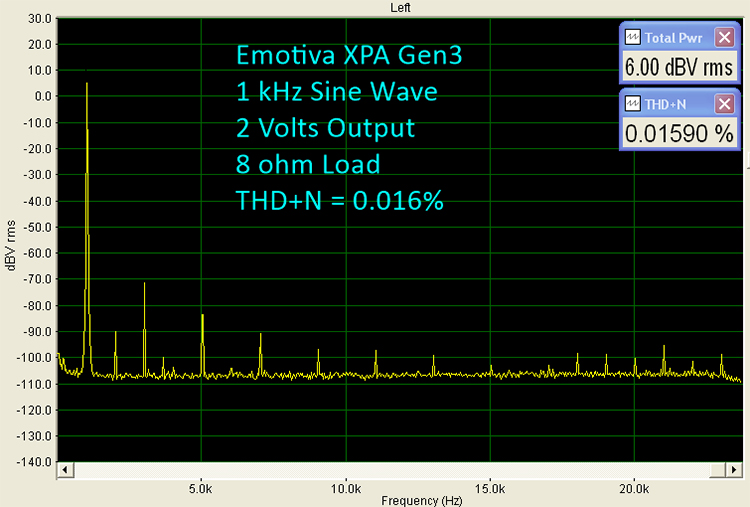
This is the first IMD test we run. The input signal is a pair of sine waves – 19 kHz and 20 kHz at a 1:1 ratio. The test determines what is the relative level of the first sympathetic inter-modulated harmonic. This is referred to as the B-A peak and occurs at 1 kHz on this test (20 kHz – 19 kHz = 1 kHz). At 2 volts, the B-A peak for the Gen3 came out at -89 dB. This again is well below the threshold of audibility.
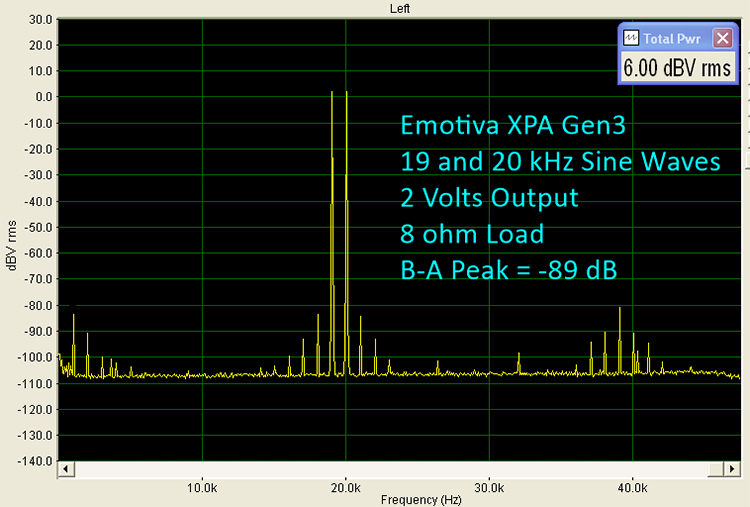
This IMD test is a bit different. The input signal is 60 Hz and 7 kHz at a 4:1 ratio. Most of the signal in music falls between 60 Hz and 7 kHz so the test signal brackets this range and the 4:1 ratio further mimics the relative levels of the signals in a typical musical waveform. So this test tells you, after a fashion, what distortion artifacts are generated when listening to actual program material. Again, the Emotiva Gen3 amp provided a wholly inaudible result – IMD 0.0044%. Excellent!
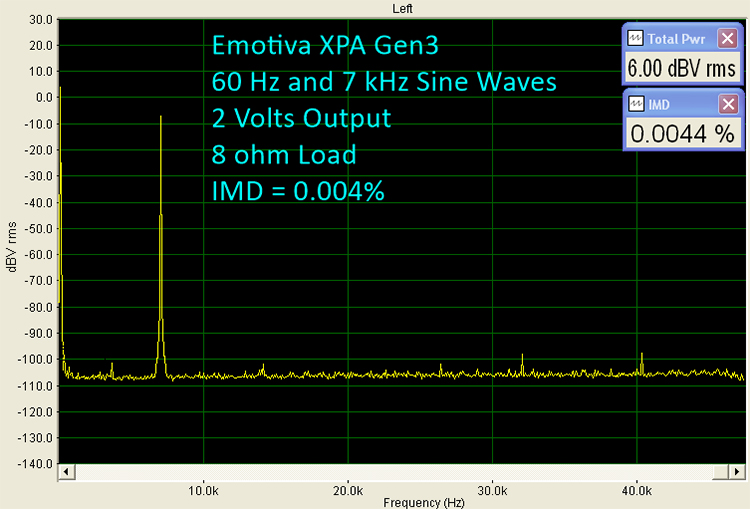
Now here is the test that corroborates my claim that the Gen3 is indeed Bad Ass. 300 watts at 8 ohms, one channel driven – THD+N = 0.00696%. Again, excellent!!!
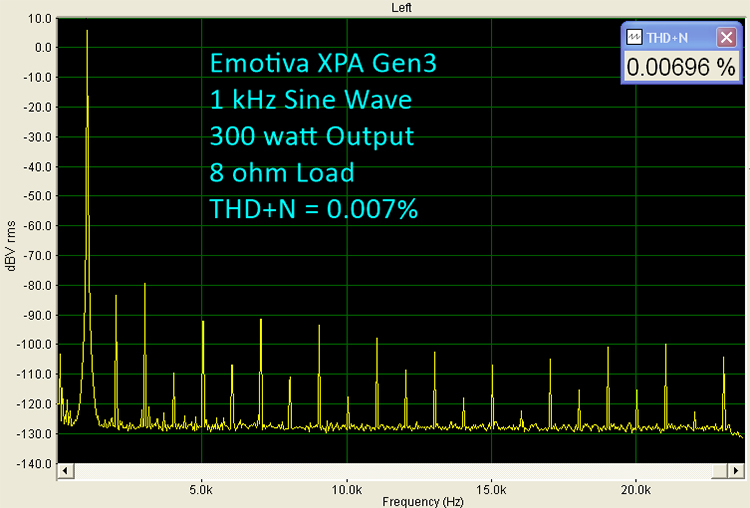
The below test plot is courtesy of Emotiva. There are certain tests that need to be done with an Audio Precision. So the good folks at Emotiva were kind enough to send me these plot they ran following our specifications. What you see below is a THD+N versus power output for a 3-channel Gen3. With Class G and Class H amplifiers, this test typically reveals a distortion bump where the power supply voltage rails shift gears to the higher voltage(s). This plot shows no obvious (or subtle) Class H bump. I am not sure exactly how they do this but it is again an excellent result.
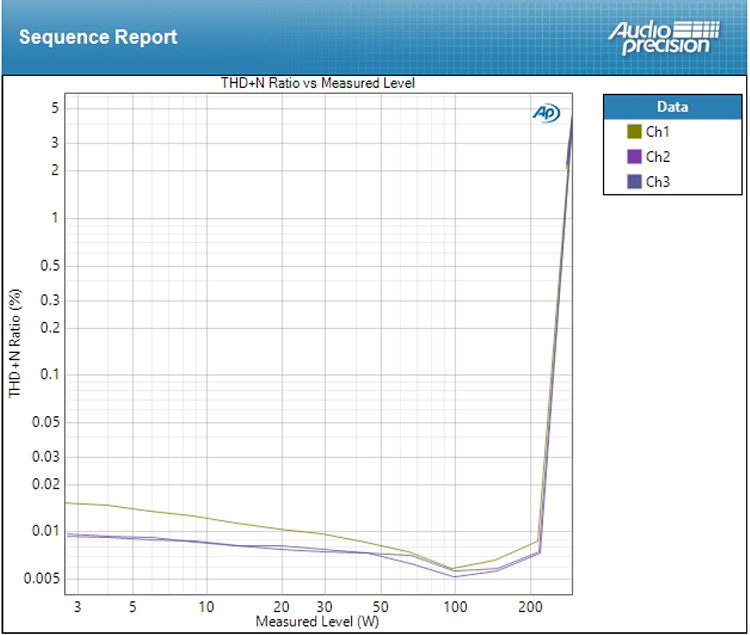
The last plot below shows the Emotiva Gen3 frequency response. The result is 20 Hz – 20 kHz +/- 0.171 dB.
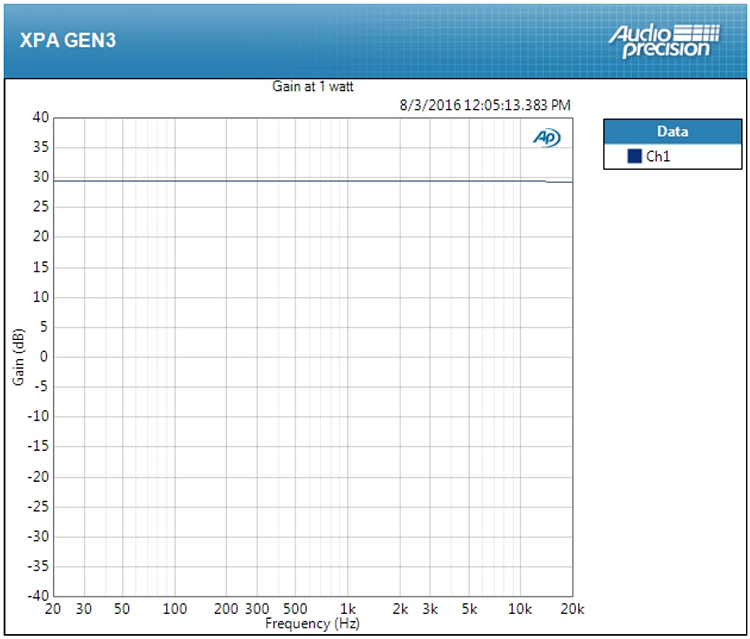
In closing, I would like to restate that the Emotiva Gen3 amplifier impressed in the listening sessions and then the actual bench tests further supported the objective aspect of the amplifier that made this performance possible.
Emotiva also provided us with details of the circuit designs of the Gen3 amp. They have a seasoned and accomplished design team and the design of this amplifier is a fine example of the science and the art of audio engineering.
So my final thought is that Emotiva continues to impress with great engineering, impressive build quality and performance that is commensurate with each of these foundational elements. I am mystified as to how they do all this at the affordable price points of their products. The Emotiva Gen3 amps have got to be far and away the best deal you can get on a power amp these days.
THE EMOTIVA XPA GEN3 POWER AMPLIFIER Lives Up to its Billing as a High Power, Low Distortion Amplifier Platform. The Emotiva Gen3 Amps Have Got to be Far And Away the Best Deal You Can Get on a Power Amp These Days.
- High power
- Light weight and cool-running
- Deep bass performance is top notch
- Lively and dynamic performance
- Model with additional power supply module for five or more channels
The Emotiva XPA Gen3 amplifier probably isn’t the most refined amplifier on the planet. But that was very hard to tell short of a direct A-B comparison. In actual use, the Gen3 really floored me. It was extremely powerful with good frequency balance and low distortion. On movies, especially the kind where things blow up, the sound it put out illuminated my listening space like very few amplifiers have.
It didn’t disappoint on music, either. With musical reproduction, the Gen3 offered a bubbly, vivid and dynamic performance that did not sound anything like the multi-channel amps from years past. It actually approached the sound of many of the better solid state stereo amps I’ve used at various times. This amp most definitely has the chops to serve double duty for cinema and music. It earns its keep on movies and then pays dividends when you want to enjoy some music!
This amp maxes out at $1,899 for seven channels. That is a very low price for a piece of gear like this. Emotiva also offers a no-risk return policy in case you don’t like what you get at this price. But I doubt very many of these amplifiers will be returned.
In closing, this amp may be for you if you enjoy action movies and love to crank them up! Oh and when it is time to settle down for a little music listening, then this amp won’t disappoint. Highly recommended.
(Editor’s Note: The amplifier reviewed here was an early production run. Emotiva has made some on the fly revisions to the circuitry in later runs that we at Secrets have yet to evaluate. These changes could possibly affect the audio performance and we will be checking out the updated version in a future installment.)


